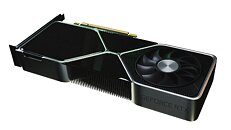Monday, August 10th 2020

Video Memory Sizes Set to Swell as NVIDIA Readies 20GB and 24GB GeForce Amperes
NVIDIA's GeForce RTX 20-series "Turing" graphics card series did not increase video memory sizes in comparison to GeForce GTX 10-series "Pascal," although the memory itself is faster on account of GDDR6. This could change with the GeForce RTX 30-series "Ampere," as the company looks to increase memory sizes across the board in a bid to shore up ray-tracing performance. WCCFTech has learned that in addition to a variety of strange new memory bus widths, such as 320-bit, NVIDIA could introduce certain higher variants of its RTX 30-series cards with video memory sizes as high as 20 GB and 24 GB.
Memory sizes of 20 GB or 24 GB aren't new for NVIDIA's professional-segment Quadro products, but it's certainly new for GeForce, with only the company's TITAN-series products breaking the 20 GB-mark at prices due north of $2,000. Much of NVIDIA's high-end appears to be resting on segmentation of the PG132 common board design, coupled with the GA102 silicon, from which the company could carve out several SKUs spaced far apart in the company's product stack. NVIDIA's next-generation GeForce "Ampere" family is expected to debut in September 2020, with product launches in the higher-end running through late-Q3 and Q4 of 2020.
Sources:
WCCFTech, VideoCardz
Memory sizes of 20 GB or 24 GB aren't new for NVIDIA's professional-segment Quadro products, but it's certainly new for GeForce, with only the company's TITAN-series products breaking the 20 GB-mark at prices due north of $2,000. Much of NVIDIA's high-end appears to be resting on segmentation of the PG132 common board design, coupled with the GA102 silicon, from which the company could carve out several SKUs spaced far apart in the company's product stack. NVIDIA's next-generation GeForce "Ampere" family is expected to debut in September 2020, with product launches in the higher-end running through late-Q3 and Q4 of 2020.

65 Comments on Video Memory Sizes Set to Swell as NVIDIA Readies 20GB and 24GB GeForce Amperes
32 GB, HBM2, 4096 bit
I'll just leave this here
If Nvidia choose to double their memory it might be due to what their expecting from AMD, or because of games they know are coming. But I'm doubtful of the latter, since games are more starved for bandwidth than memory capacity as of now.
Perhaps "big navi" is a ~60 CU 256-bit memory card, affordable, decent, but no high-end card. ;)
Look at their banner.
My money's on this being made up entirely, or something for datacenter parts.
Mainstream 20 series cards were pretty skimpy on memory only 8gb's compared to 1080ti 11gb's so any additional memory would be welcomed
But then again they aren't talking or guessing on mainstream cards are they and these would be north of any mainstream gaming budget.
Imho Turing is/was one of the worst Nvidia series. Not because it was late, slow or hot. Rather it's price/perf was very poor. It did not offer meaningful upgrade over Pascal (unless you upgraded from 1060 to 2080 or something). The launch was botched, unprofessional and very haphazard. Very unusual for Nvidia who is usually known for well executed launches.
The new features are only now somewhat worth it but game support is very limited still.
I expect Ampere to be much bigger step due to 7/8nm and possible AMD competition.
Yep
I recently got a 150.00 evga 980ti sc just to hold me over on a meager machine and a friend said something about a 2060KO a 350.00 card lol both 6gb cards :)
But yeah I'm passing on 20 series completely by design
All the early dead ones pretty much made that policy.
When 1080ti released mining wasn't a problem
It was months after release evga 1080ti ftw3 very close to top of the line gpu was 770.us at micro center where i got mine other 1080ti's were much lower 600.us range.
But yes later mining completed exaggerated prices.
and all I'm playing is flight sims and Counter Strike GO.
Much faster SSD to GPU RAM transfers hence no need to pre-load data that is not immediately displayed is stated as the reason for going with conservative sizes (Cerny @ Sony)
Why would PC graphic cards of the next gen need more than 16GB? FOr people without SSDs?
Even going beyond 10GB seems an overkill.